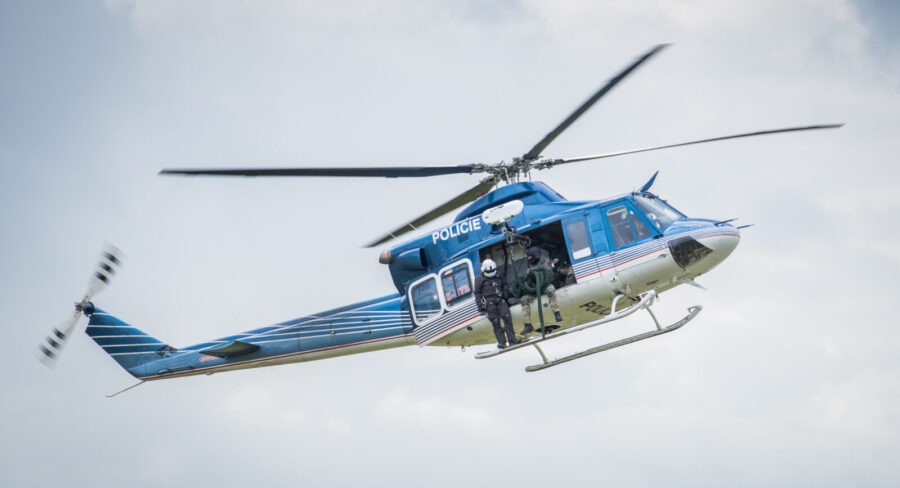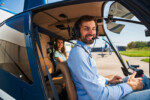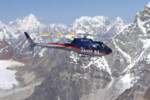What do Police Helicopters do?
29 August 2022 | Updated on February 05, 2024
Police helicopters can be valuable tools for ensuring public safety or irksome noisy machines disturbing a neighborhood’s peace, depending on your perspective. They play a vital role in police duties and are typically deployed when no alternatives exist. Although helicopters can be expensive to operate, they save considerable time and resources. Police departments in large cities use helicopters for their versatility and because it saves time. A helicopter flies directly to where it is needed and can land on almost any terrain to disembark or evacuate victims or personnel. Helicopters on police emergencies fly over traffic and congested roads, helping police officers respond faster to criminal activity.
Helicopters perform several functions like giving cops a clear overview of an active crime scene, surveilling and tracking crime suspects, searching for missing persons, fugitives, or property, monitoring large public gatherings, assisting police patrol vehicles in a high-speed pursuit of fleeing offenders or fugitives, air traffic control, personnel transport, and so much more.


You are not alone if you have ever wondered why a helicopter is circling over your house, street, or community. There are divided opinions on what helicopters do. Several people think police helicopters are indispensable tools for law enforcement. At the same time, some believe that using police helicopters is a form of over-policing that makes life miserable for everyone. This article sheds light on what police helicopters do, how they perform their functions, and why police helicopters help solve crimes, making your community safer for you, your family, and your friends.
Why do the police use helicopters?
To save time and resources
Police helicopters save significant time performing police duties while using much fewer resources. For example, the Dyfed-Powys police force claims its police helicopter can perform a square mile search within twelve minutes for the cost of £160. In contrast, it takes twelve police officers 454 hours to cover a similar area for £4,500.
Tracking fleeing suspects
Police helicopters do an excellent job monitoring crime suspects running on foot or hiding in ditches, barns, or alleys. Observers in overhead helicopters who have a better view of the environment and the direction the suspect is heading relay the information to pursuing officers on the ground. Also, nighttime tracking equipment like spotlights and thermal imaging devices aid observers in the helicopter in locating suspects.
Surveillance
Police departments often deploy helicopters when investigating crime and criminal gangs. Surveillance can be in the form of observing oblivious criminals, gangs of criminals, or asset tracking. Asset tracking entails monitoring movements and the location of stolen property, drugs, or undercover agents on special missions.
Managing high-speed chases
Managing and reporting car chases is one of a police helicopter’s most famous roles. And if you are like us, you probably love watching thousands of television, and YouTube police car chases filmed by overhead helicopters. Observers inside police helicopters track the movement of a fleeing vehicle from above and report its location to the pursuing officers. The latter can pull back to avoid collisions with other vehicles.


Monitoring large public gatherings and events
Helicopters can scan large spaces and crowds efficiently, allowing observers to quickly notice and report suspicious or unruly activities to ground patrol officers.
Enforcing access to restricted areas
When the airspace over airports, large public celebrations, parades, sports events, disasters, historic public buildings, and monuments are closed to general aviation traffic. Police helicopters prevent unauthorized aircraft from flying into the restricted airspace and escorting them out.
Support for special operations
Police helicopters often provide “eye-in-the-sky” support during special police operations like drug busts by delivering live overhead video feed to ground command centers. The information helps monitor the overall progress of the operation, identifying any threats, and letting the police know of any escape attempts by the suspects.
Rapid personnel deployment
A central role of police helicopters is to rapidly deploy police specialist units, including SWAT teams, into crisis areas. Helicopters can also land men on rooftops, boats, bridges, and skyscrapers, where they can quickly access crime scenes by rappelling down or making forced entry to gain control.
Search and rescue
Police departments often use helicopters to search for missing people, including young children and older people. Helicopters assist ground search teams by covering a larger area, and onboard observers can relay information on possible sightings to ground-based police officers to confirm. Also, police helicopters rescue missing persons, often assisting in extraction and subsequent evacuation.
What does a police helicopter look like?
Police helicopters do not have a standard paint scheme, making identification difficult for civilians. However, police helicopters have bold POLICE lettering prominently on their fuselage, which can quickly help you identify one. Most local or state police departments paint their helicopters whatever color they choose but will incorporate the badge used on their squad cars on the aircraft’s livery. Also, the name of the owner agency is painted on the fuselage or tail section. For example, police helicopters belonging to the Scotland Yard have a dark blue color and a bright yellow roof with the word POLICE written on both sides of the fuselage in bold yellow.
Who is in charge of operating a police helicopter?
A law enforcement pilot, also known as a line pilot, is in command of a police helicopter during operations. Line pilots are helicopter pilots with a commercial pilot license. Some line pilots have military experience and may receive specialized training, including basic law enforcement training. Line pilots are police officers employed in the air wing of a law enforcement agency.
Law enforcement pilots’ duties range from flying their helicopters during police operations to ensuring the aircraft is well maintained and ready to fly. They fly with a crew of two policemen who work the helicopters’ cameras, maps, and other police gear, and they must be available every day depending on the police department and the work rate.


What Equipment Can You Find On A Police Helicopter?
Police helicopters are essentially modified versions of standard models, with their cockpits boasting a dizzying array of high-tech specialized equipment designed to help police departments fight crime and maintain public safety. Police mission equipment is complex and expensive, with prices similar to the cost of a standard helicopter.
Examples of the equipment you can find in a police helicopter include:
- Police radios: multiple two-way police radios are often mounted in the cockpit to facilitate direct communications between the helicopter observers and ground units. The radios are designed for use independently from any position within the aircraft without impeding flight operations.
- Cameras: forward-looking infrared video cameras with thermal imaging systems are becoming standard systems on police helicopters globally. This equipment is mounted below the fuselage and provides HD quality video feed, including heat signature images to screens inside the helicopter’s cockpit, allowing observers to record and transmit clear color pictures of suspects and other details to ground communication centers.
- Video recorders: on-board video recorders are also standard on police helicopters. Modern video recording devices are typically large-capacity hard drives for storing video, picture, and audio data for further analysis.
- Searchlight: the image of a cornered fugitive frantically trying to escape the bright searchlights of a hovering police helicopter is a familiar sight in Hollywood movies. Searchlights are perhaps the oldest pieces of equipment on police helicopters. Their purpose includes illuminating crime scenes, exposing the location of hiding or fleeing criminals, and aiding pilot visibility during landing. Police helicopter searchlights can be adjusted to allow helicopter crews to use night vision goggles during night operations. They can be programmed to mirror the aim of the helicopter’s video cameras.
- Digital maps: are an essential tool for police helicopter crews, and they are a vital navigation aid and provide reference during grid searches for missing persons. Modern digital maps are sophisticated moving maps showing the helicopter’s position with real-time satellite feed complete with street and property information replacing static electronic maps found on older helicopters.
- Night Vision Goggles: night vision equipment helps the police helicopter pilot and crew spot obstacles and terrain during nighttime operations preventing collisions and accidents. Night vision goggles aid observers during night searches and rescue missions when \ spotting missing persons and accident victims.
Police helicopters can carry other equipment, including telecommunication devices like satellite phones. Police helicopters are also fitted with auxiliary batteries to power all the extra equipment and safety equipment like fire suppression systems.
Do police helicopters fly at night?
Crime never stops, and neither does police work. The sight of police helicopters hovering over a sleeping neighborhood in the dead of night with their searchlights illuminating empty streets is a common sight in many big cities because police helicopters are required to respond to criminal activity, whether during the day or at night. Police helicopters are equipped to fly at night because the police might need them for emergencies ranging from Friday night police pursuits to midnight searches for a missing person.
Police helicopter pilots and crew have nighttime flight training and can conduct flights during bad weather. Police helicopters also have advanced equipment to perform their roles at night. For example, thermal imaging cameras on police helicopters can detect heat sources allowing pilots to identify people and objects quickly in the dark. Police helicopter pilots and crews also wear night vision goggles, giving them better visibility during night operations.


Why do police helicopters circle?
An interesting note about police helicopters is that people always notice them when circling rather than during conventional flights. It may look like police helicopters spend most of their time circling, but they only do this for specific reasons, which we will highlight below.
- Police helicopters fly in circles when searching for a fugitive or missing persons because circling is the most efficient method of scanning an area from the sky.
- Police helicopters often circle before landing to give the pilot an excellent viewpoint of the landing area and determine the ideal landing approach.
- Another reason why police helicopters fly in circles is to achieve better fuel efficiency. Helicopters use less power when circling than when hovering, resulting in lower fuel consumption.
- Police helicopters circle to avoid becoming an easy target for criminals and gangsters on the run.
- Police helicopters circle to avoid creating a downwash of dirt and debris. Helicopter engines can suck up the downwash into their turbines resulting in an engine shutdown which can lead to an accident.
Conclusion
Police helicopters perform several roles within police departments that benefit the community, and they are not a sign of excessive policing but indispensable tools for ensuring law and order. So, trying to relax when a buzzing police helicopter awakens you from your sleep is a good idea. And instead of getting angry, thank the dedicated police officers who are risking their lives to keep you and your family safe.





























